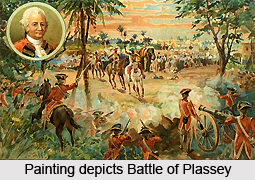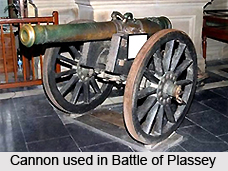 Significance of Battle of Plassey lies in the fact that Bengal came under the oppression of the British. The battle was not important from the military view-point. It was a mere conflict. No military superiority was shown by the English army. The Nawab`s camp was deserted that lead to victory of Lord Clive. Mir Jafar and Rai Durlabh were not faithful thereby changing the outcome of the battle. Due to their disloyalty the Nawab drove away from the battlefield. Lord Clive`s diplomacy excelled. He won the battle without fighting. According to some historians it was a transaction in which the bankers of Bengal and Mir Jafar sold out Nawab to the English.
Significance of Battle of Plassey lies in the fact that Bengal came under the oppression of the British. The battle was not important from the military view-point. It was a mere conflict. No military superiority was shown by the English army. The Nawab`s camp was deserted that lead to victory of Lord Clive. Mir Jafar and Rai Durlabh were not faithful thereby changing the outcome of the battle. Due to their disloyalty the Nawab drove away from the battlefield. Lord Clive`s diplomacy excelled. He won the battle without fighting. According to some historians it was a transaction in which the bankers of Bengal and Mir Jafar sold out Nawab to the English.
Plassey put the British oppression on Bengal which could not be put off. Mir Jafar was dependent on the Britishers so as to maintain his position in Bengal as well as protection against foreign invasions. An English army of 6,000 troops was maintained in Bengal to help the Nawab. All real powers passed into the hands of the Company. Mir Jafar could not punish Diwan Rai Durlabh and Ram Mrayan for disloyalty due to British supremacy.
 Mir Jafar felt the English oppression annoying and conspired with the Dutch to expel the English from Bengal. Clive defeated the Dutch at Bedara. Mir Jaffar had to give place to Mir Qasim who was a nominee of the Company in 1760.
Mir Jafar felt the English oppression annoying and conspired with the Dutch to expel the English from Bengal. Clive defeated the Dutch at Bedara. Mir Jaffar had to give place to Mir Qasim who was a nominee of the Company in 1760.
The battle of Plassey followed the subsequent plunder of Bengal as Bengal was placed at the disposal of the English vast resources. After Plassey a sum of Å“800,000 was given to the Company. Bengal was considered as the most prosperous province, industrially and commercially. The vast resources of Bengal helped the Britishers to conquer the Deccan and extend their influence over North India.
Before the Battle of Plassey English Company was just one of the European Companies trading in Bengal and huge taxes were imposed by the Nawabs of Bengal. After Plassey the English virtually monopolised Bengal`s trade and commerce. The French was unable to recover their lost position. The Dutch was also defeated. From commerce the English managed to exert an exclusive control on the administration too. Plassey proved as a battle that had far-reaching consequences in the fate of India.
The battle of Plassey was an important event in the chain of developments that made the English the rulers of India. The consequences of Plassey shaped the form of British superiority and the methods of cultural contact.



















